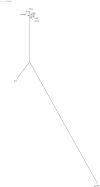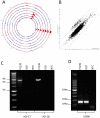Exploring the zoonotic potential of Mycobacterium avium subspecies paratuberculosis through comparative genomics
- PMID: 21799786
- PMCID: PMC3142125
- DOI: 10.1371/journal.pone.0022171
Exploring the zoonotic potential of Mycobacterium avium subspecies paratuberculosis through comparative genomics
Abstract
A comparative genomics approach was utilised to compare the genomes of Mycobacterium avium subspecies paratuberculosis (MAP) isolated from early onset paediatric Crohn's disease (CD) patients as well as Johne's diseased animals. Draft genome sequences were produced for MAP isolates derived from four CD patients, one ulcerative colitis (UC) patient, and two non-inflammatory bowel disease (IBD) control individuals using Illumina sequencing, complemented by comparative genome hybridisation (CGH). MAP isolates derived from two bovine and one ovine host were also subjected to whole genome sequencing and CGH. All seven human derived MAP isolates were highly genetically similar and clustered together with one bovine type isolate following phylogenetic analysis. Three other sequenced isolates (including the reference bovine derived isolate K10) were genetically distinct. The human isolates contained two large tandem duplications, the organisations of which were confirmed by PCR. Designated vGI-17 and vGI-18 these duplications spanned 63 and 109 open reading frames, respectively. PCR screening of over 30 additional MAP isolates (3 human derived, 27 animal derived and one environmental isolate) confirmed that vGI-17 and vGI-18 are common across many isolates. Quantitative real-time PCR of vGI-17 demonstrated that the proportion of cells containing the vGI-17 duplication varied between 0.01 to 15% amongst isolates with human isolates containing a higher proportion of vGI-17 compared to most animal isolates. These findings suggest these duplications are transient genomic rearrangements. We hypothesise that the over-representation of vGI-17 in human derived MAP strains may enhance their ability to infect or persist within a human host by increasing genome redundancy and conferring crude regulation of protein expression across biologically important regions.
Conflict of interest statement
Figures






References
-
- Chiodini RJ, van Kruiningen HJ, Thayer WR, Merkal RS, Coutu JA. Possible role of Mycobacteria in inflammatory bowel disease .1. An unclassified Mycobacterium species isolated from patients with Crohn's disease. Dig Dis Sci. 1984;29:1073–1079. - PubMed
-
- Kirkwood CD, Wagner J, Boniface K, Vaughan J, Michalski WP, et al. Mycobacterium avium subspecies paratuberculosis in children with early-onset Crohn's disease. Inflamm Bowel Dis. 2009;15:1643–1655. - PubMed
-
- Pavlik I, Falkinham JO, Kazda J. Potentially pathogenic mycobacteria. In: Kazda J, Pavlik I, Falkinham JO, Hruska K, editors. The Ecology of Mycobacteria: Impact on Animal's and Human's Health. New York: Springer; 2009. pp. 21–80.
Publication types
MeSH terms
LinkOut - more resources
Full Text Sources
Other Literature Sources
Molecular Biology Databases
Research Materials

